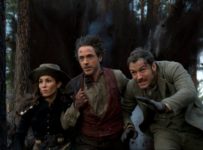A truly unique film not only showcases the superb Sean Penn, but examines America from the outside in the ultimate goth road trip.
[stextbox id=”grey” caption=”This Must Be The Place (2012)” float=”true” align=”right” width=”200″]
Director: Paolo Sorrentino
Writer(s): Paolo Sorrentino, Umberto Contarello
Runtime: 106 minutes
Starring: Sean Penn, Frances McDormand, Judd Hirsch, Eve Hewson
Distributor: Hopscotch
Country: France, Ireland, Italy
Rating: Certified Bitstastic (?)
[/stextbox]
Following Italian director Paolo Sorrentino‘s Jury Prize at the 2008 Cannes Film Festival for Il Divo, it is said that the head juror that year determined that he must work with this emerging master. That jury head was, of course, actor and director Sean Penn, who has made a career of reinventing himself on both sides of the camera. The resulting film, Sorrentino’s first in English, is a idiosyncratic blend of pictures, music and performance from the collective minds of the director, its star and musician David Byrne. Indeed, it was Byrne’s amazing track “This Must Be the Place (Naïve Melody)” that served as the inspiration for the film’s title.
Cheyenne (Sean Penn) is a retired American rock star, leading a bored domestic life in Dublin with his outgoing firefighter wife Jane (Frances McDormand). Learning of his estranged father’s death, he travels to New York, where he learns the full extent of his father’s humiliation at the hands of the Nazis during the Second World War. Cheyenne embarks on a journey across America to not only find the SS officer in hiding, but to rediscover something about himself as well.
At the heart of this compelling personal journey is Penn’s outstanding performance of Cheyenne, quite unabashedly based on The Cure’s Robert Smith. Despite retirement, he maintains his full stage makeup at all times, whether reading the paper or dragging his cart down to the shops to do the weekly shopping at a Tesco. He is initially presented as a lost soul, one that only has an identity in relation to others: husband, rock god, weirdo with a black shock wig, son or simply friend to Goth follower Mary (Eve Hewson). With his diminutive voice, Penn is the most unassuming rock star to ever drift through life. Jane tells him that she can’t live without him. “That’s not true”, he replies in resignation “but it’s kind of you to say”. It is only when Nazi hunter Mordecai Midler, portrayed with an amazing richness by Judd Hirsch, that Cheyenne is given any solo direction in his life.
Once Cheyenne begins his road trip, in a pick up truck a random Texan entrusted him with, Sorrentino’s vision of America shares some similarities with Wim Wenders’ Paris, Texas, another European perspective on the roads of the United States, right down to the presence of Harry Dean Stanton. Penn’s Cheyenne could be the spiritual twin of Stanton’s Travis Henderson. “At this particular moment I’m trying to fix up a sad boy and a sad girl, but it’s not easy. I suspect that sadness is not compatible with sadness”. Cheyenne encounters David Byrne, playing himself, and once again he feels his accomplishments pale in comparison to Byrnes. There is also a mother and son living in the desert who remind him of the importance of the family unit in his quest, and an exchange between the boy and Cheyenne is priceless. Together they perform the title track, which the boy insists is an Arcade Fire track despite Cheyenne’s insistence that the song is, in fact, from Talking Heads.

If This Must Be The Place is the successor to Paris, Texas, then it comes from a far less nihilistic place, one where humanity is full of surprises. Visually striking, veteran cinematographer and frequent Sorrentino collaborator Luca Bigazzi brings a look similar to Quentin Dupieux’s Rubber (2010) to this brightly contrasted and often leisurely odyssey. The diversions into Nazi hunting may seem tangential to Cheyenne’s redemption, but it is the impetus he needs to get him back in the world. The trip back is a strange and sometimes surreal one, but like all the best voyages it is ultimately the journey and not the baggage that make this an enjoyable one.
This Must Be The Place is released in Australia on 5 April 2012 from Hopscotch.





